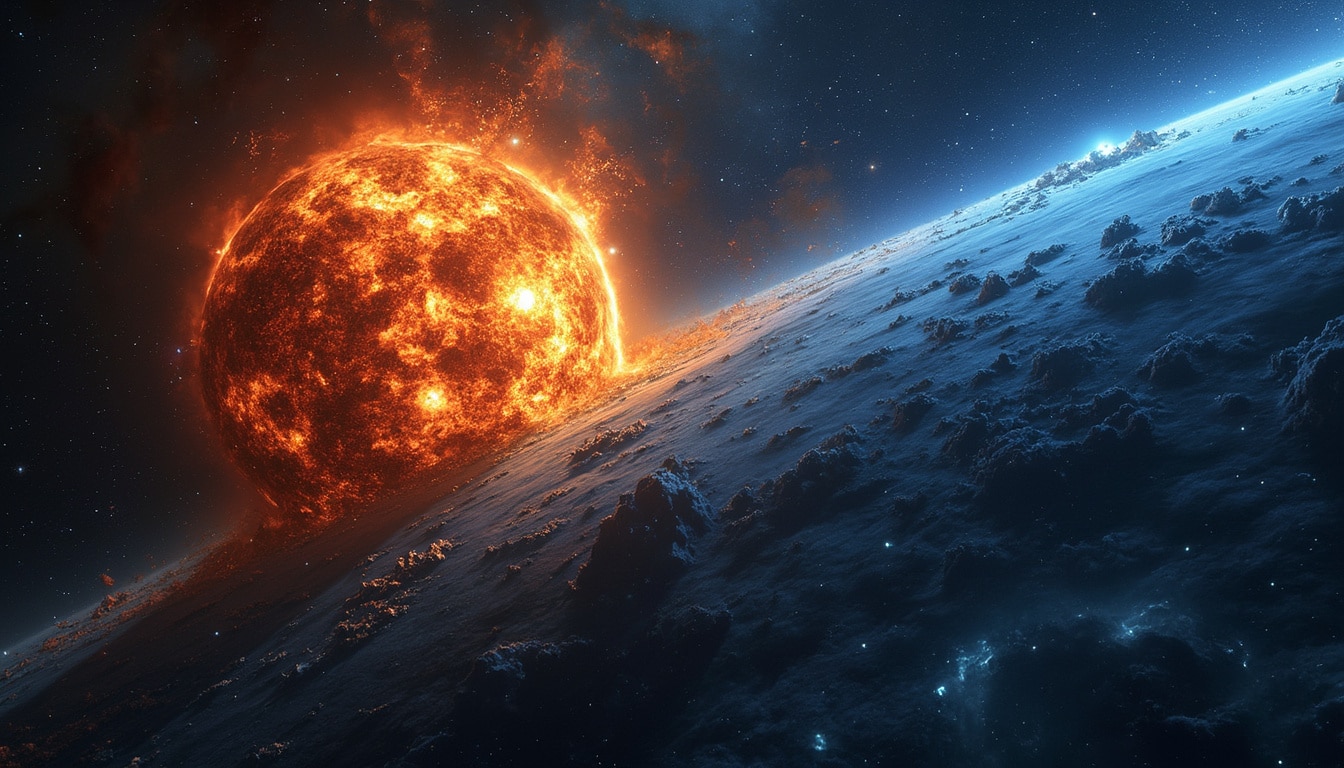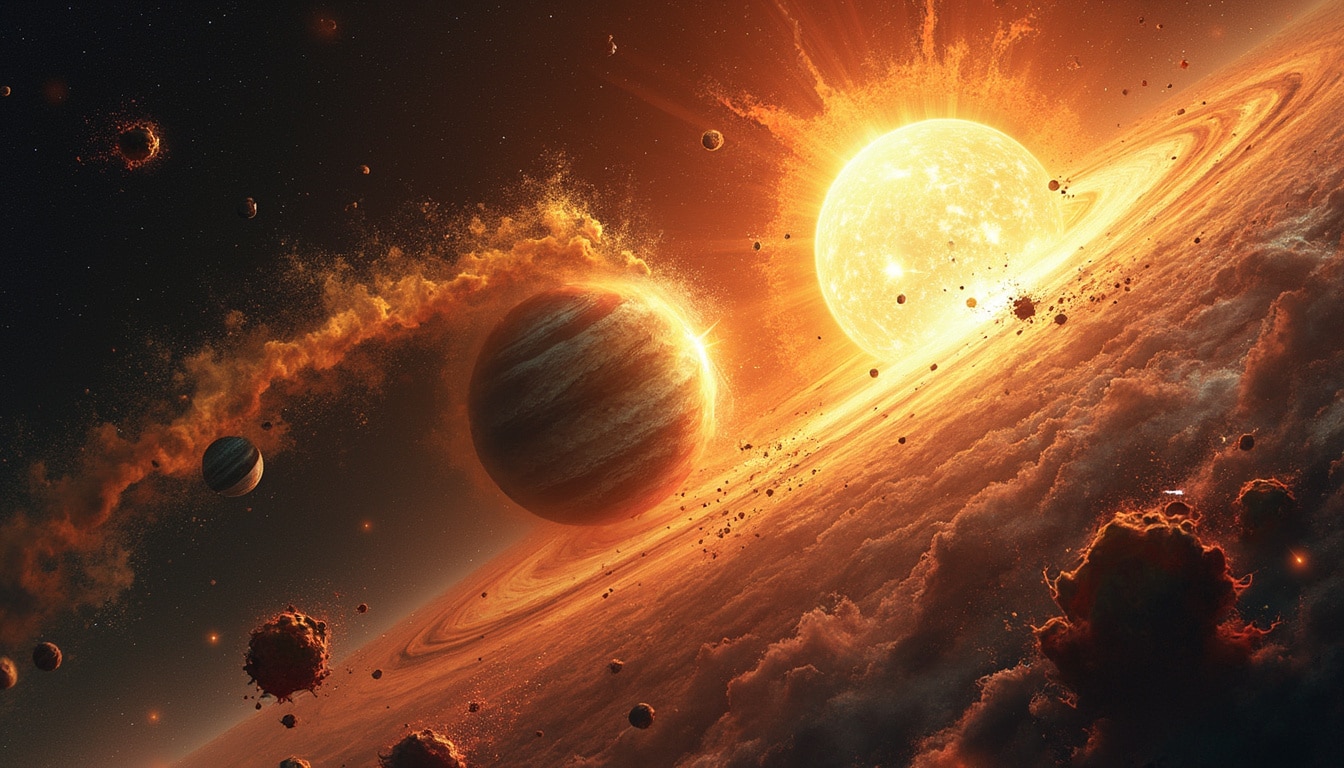NASA’s recent examination of a distant event where a star was observed consuming a planet has unveiled astonishing insights, reshaping our understanding of stellar behavior and planetary fate. With the advancements of the James Webb Space Telescope, scientists have been able to gather intricate details about this cosmic interaction. Initially believed to be a typical star swelling to engulf a nearby planet, the latest findings suggest a more complex process involving the gradual orbital decay of the planet leading to its eventual demise. This article delves into the fascinating details of this observation and what it might mean for future research into planetary systems.
The Nature of the Event: A Cosmic Encounter
At the heart of this revelation lies a stellar event formally classified as ZTF SLRN-2020, situated approximately 12,000 light-years from Earth in the Milky Way galaxy. Originally detected as a bright flash of optical light by the Zwicky Transient Facility in California, this phenomenon immediately caught the attention of astronomers eager to understand its implications. As new data emerged from NASA’s NEOWISE and the James Webb Space Telescope, researchers began piecing together an intricate story involving a star behaving differently than expected.

The Role of the James Webb Telescope
NASA’s James Webb Space Telescope has been pivotal in observing this event. Using its powerful instruments, Webb provided insights that fundamentally altered the initial interpretation of the star’s behavior. Instead of merely expanding to consume a planet, observations revealed that the planet’s orbit gradually decayed over millions of years, pulling it closer to the star until it was ultimately engulfed. This observation marks a significant advancement in our understanding of how stars interact with nearby celestial bodies.
Key Scientific Instruments
Two vital instruments aboard the James Webb Space Telescope played crucial roles in this investigation—MIRI (Mid-Infrared Instrument) and NIRSpec (Near-Infrared Spectrograph). Their combined capabilities allowed astronomers to scrutinize the star’s emissions and those of its surrounding environment with unprecedented detail. The instruments revealed that the star lacked brightness associated with aging into a red giant, supporting the conclusion that the planet’s demise was a more complex tale than previously thought.
The Journey of the Planet: An Orbital Decay
Investigations into the demise of the swallowed planet suggest that it was initially comparable to Jupiter in size, but during its lifetime, it orbited much closer to the star than Mercury does around our Sun. This proximity led to a catastrophic chain of events as the planet started to interact with the star’s atmosphere. Morgan MacLeod, a team member from the Harvard-Smithsonian Center for Astrophysics, described how the planet gradually began to graze the star’s atmosphere, eventually beginning a runaway spiral that culminated in its engulfment.

The Catastrophic Consequence
The eventual swallowing of the planet would have had a dramatic effect on the star itself, initially leading to a blast of gas that expelled material from the star’s outer layers. This flash of activity created a swirling chaos that allowed for the analysis of subsequent dust and gas emissions emitted from the star post-digestion. One of the intriguing findings was a hot circumstellar disk of molecular gas surrounding the star, characterized by elements such as carbon monoxide. This disk gives researchers an unprecedented view into the aftermath of celestial interactions.
The Impact on Stellar Evolution Studies
The findings from this observation significantly impact our understanding of planetary systems and how they evolve. There’s a wealth of knowledge yet to be uncovered about the stages leading to planetary destruction and the subsequent behavior of the star. Researchers anticipate that the insights gained from this event will not only inform future studies of similar occurrences but also enhance our understanding of the life cycle of stars and their planetary companions.
The Future of Stellar Observations
As astronomy continues to progress, the study of situations like this one will likely intensify. NASA and its partner organizations, including the European Space Agency, are committed to expanding observations of the universe using tools like the James Webb Space Telescope, as well as other upcoming missions such as the Vera C. Rubin Observatory and NASA’s Nancy Grace Roman Space Telescope. These systems are expected to survey extensive areas of the cosmos, enabling research teams to identify relevant events for study, potentially leading to discoveries that could transform our knowledge of the universe.
Advancements in Technology
With the help of advanced technologies and collaborations between aerospace entities like SpaceX, Boeing, and Blue Origin, the landscape of space exploration is changing rapidly. These companies are playing vital roles not only in launching telescopes and satellites but also in creating new opportunities for observing celestial events. With innovative spacecraft and research facilities, organizations are now better equipped to study distant worlds and the interactions that take place in various solar systems.
Anticipated Discoveries
The anticipated advancements in technology and methodology are set to yield a wealth of discoveries about not only stellar consumption of planets but also broader astrophysical phenomena. Upcoming surveys aim to capture and categorize transient events on an unprecedented scale. By continuously refining observational techniques, astronomers will be able to trace the life cycles of stars and their surrounding planetary systems more effectively. Materials collected in these observations can also yield essential information about the origins of the chemical elements found in our own Solar System.
Who Will Lead the Future Explorations?
The growing interest in space research and exploration has created opportunities for various organizations beyond NASA. Private entities like Planet Labs and Sierra Nevada Corporation, as well as corporate alliances with Northrop Grumman, are augmenting the scientific community. As new leaders emerge in this space exploration era, we can anticipate a more collaborative approach to studying celestial phenomena, ensuring that even the smallest discoveries are met with the same enthusiasm as groundbreaking revelations.
A Collaborative Effort
Many of these pioneering organizations are working together harmoniously to bridge the gap between commercial interests and scientific aspirations. By fostering partnerships, the space industry can ensure a steady flow of resources and knowledge sharing. This teamwork is expected to lead to more efficient missions that could unlock the mysteries of black holes, neutron stars, and other cosmic wonders. The blend of established space organizations and new entrants into the field forms a melting pot of creativity and innovation.
International Interests in Space Exploration
The dynamic nature of astronomy has inspired interest from nations around the globe. Numerous countries are investing in their own space programs, leading to a wealth of new ideas and techniques. Collaborative ventures, such as those led by the European Space Agency, play an important role in articulate sharing findings and pooling resources for projects like the upcoming lunar missions and Mars exploration initiatives. The shared goal of unraveling the secrets of the universe fosters a sense of unity among nations as they work towards the same aspirations of discovery.
| Space Exploration Companies | Primary Focus | Recent Advances |
|---|---|---|
| NASA | Space telescopes and planetary missions | Launch of the James Webb Space Telescope |
| SpaceX | Commercial space flights and satellite launches | Resilience in launching satellites, including Starlink |
| Blue Origin | Suborbital and orbital flights | Focus on lunar landing technologies |
| Boeing | Crewed space missions | Collaboration on the Space Launch System |
| Northrop Grumman | Satellite launches and resupply missions | Increasing capabilities in aircraft manufacturing and orbital missions |




Leave a Reply